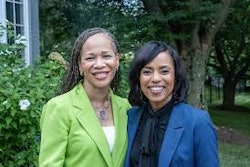A new report from the Women’s Power Gap Initiative at the Eos Foundation and the American Association of University Women found that while 60% of all higher ed professionals are women, 76% of top earners and 82% of number one earners are men. And women of color are “virtually nonexistent” among the top-earning positions in higher education.
“We didn’t expect to find a large number of women of color, but we didn’t expect that they’d be only 2.5% cumulative” across all top-earning positions in higher ed, said Eos Foundation President Andrea Silbert, who authored the report, titled, “The Power Gap Among Top Earners at America’s Elite Universities.” The report examines gender, race and ethnicity among ten most highly compensated employees at 130 major research institutions in the U.S.
AAUW CEO Kimberly Churches wasn’t too shocked by the findings, she said. “I’ll explain it for you: It’s called bias, and that’s why this gap is occurring.”
 Kimberly Churches
Kimberly Churches“The pipeline is there,” Churches said, adding that women have been besting men in degree attainment “for decades.” Women earn 54% of all Ph.D.s and 60% of all master’s degrees, yet hold only 2% of top-earning positions at universities. The report finds that women of color earn 16% of all Ph.D.s yet comprise only 2% of top earners at top-tier higher ed institutions.
“This is about occupational segregation,” Churches said. “The higher we go up in professions, the issues we have on the wage gaps are worse.”
Some of it is cultural. For example, men who come into negotiating meetings to discuss employment and compensation often bring lawyers, which is almost unheard of for women in the same seats, according to Silbert. But Churches said focusing on cultural norms and negotiation trends “put the onus on us as women (or people of color)” to correct structural and institutional biases.
The report recommends university boards and leadership teams take proactive steps to address their own biases and help close the gaps. For starters, banning compensation history as an interview component and determination for pay setting. The authors also recommend examining the diversity of the boards themselves to ensure they reflect the kind of diversity they’re looking to attract and “conduct regular audits to root out unconscious bias.” They also suggested presidents and boards create benchmarks to measure progress and “make bold, long-term public commitments to reach equitable representation of women and people of color.”
At Boston University, for example, having a female provost has helped make closing the gender gap a priority.
“Every dean gets equity dollars every year that we can use to help close any gaps or any disparities among faculty members. It allows for correction where there are gaps that should no longer exist,” according to the university’s stated goals, said Angela Onwuachi-Willig, Dean of Boston University School of Law. Putting dollars behind the stated priority and tying it to performance reviews for the leadership team means university leaders are forced to examine their progress at least once a year when they’re doing reviews and planning the budget for the next year.
“It communicates to everyone at the university that this is something we should care about,” Onwuachi-Willig said. “It makes an issue salient for some people for whom it might not otherwise be salient.”
Silbert said all universities must develop a plan to address the disparities.
“Universities are the moral exemplars of our community,” she said. “We trust them to show our youth the world as it should be, not just reinforce the many structural injustices that there are.”


















